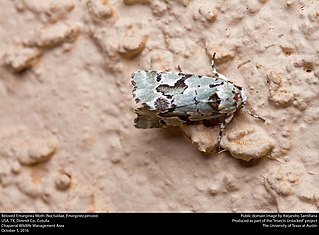
Acontiinae is a subfamily of bird dropping moths in the family Noctuidae. There are more than 50 genera and 430 described species in Acontiinae, found worldwide in temperate and tropical climates.

Amphipyrinae is a subfamily of owlet moths in the family Noctuidae. There are more than 50 genera and 210 described species in Amphipyrinae, although the classifications are likely to change over time.

Metalectra is a genus of moths of the family Erebidae described by Jacob Hübner in 1823.
Drasteria petricola, the little arches, is a moth of the family Erebidae. The species was first described by Francis Walker in 1858. It is found in western North America from Yukon and the Northwest Territories south to New Mexico in the Rocky Mountains, east to Manitoba.

Metalectra discalis, the common fungus moth, is a moth of the family Erebidae. The species was first described by Augustus Radcliffe Grote in 1876. It is found in North America from Wisconsin to Quebec and Maine, south to Florida, west to Texas and Missouri, north to Ontario.
Omphalocera occidentalis is a species of snout moth in the genus Omphalocera. It was described by William Barnes and Foster Hendrickson Benjamin in 1924 and is known from the US states of Nevada, Arizona and New Mexico.
Comadia dolli is a moth in the family Cossidae first described by William Barnes and Foster Hendrickson Benjamin in 1923. It is found in North America, where it has been recorded from Arizona, California, Nevada and New Mexico.
Comadia intrusa is a moth in the family Cossidae first described by William Barnes and Foster Hendrickson Benjamin in 1923. It is found in North America, where it has been recorded from New Mexico, Arizona and California.
Comadia subterminata is a moth in the family Cossidae first described by William Barnes and Foster Hendrickson Benjamin in 1923. It is found in North America, where it has been recorded from Arizona, Utah, Colorado and New Mexico.

Elophila gyralis, the waterlily borer moth, is a moth in the family Crambidae. It was described by George Duryea Hulst in 1886. It is found in eastern North America, where it has been recorded from Alabama, Florida, Georgia, Illinois, Indiana, Iowa, Louisiana, Maine, Maryland, Massachusetts, Michigan, Minnesota, Mississippi, New Brunswick, New Hampshire, New Jersey, New York, North Carolina, Nova Scotia, Ohio, Oklahoma, Ontario, Pennsylvania, Quebec, South Carolina, Tennessee, Texas and Wisconsin.

Noctueliopsis aridalis is a moth in the family Crambidae. It was described by William Barnes and Foster Hendrickson Benjamin in 1922. It is found in North America, where it has been recorded from Arizona, California and Nevada. The habitat consists of deserts.
Apilocrocis pimalis, or the Pima apilocrocis moth, is a moth in the family Crambidae. It was first described by William Barnes and Foster Hendrickson Benjamin in 1926.

Metalectra tantillus, the black fungus moth, is a moth of the family Erebidae. The species was first described by Augustus Radcliffe Grote in 1874. It has been recorded from the US states of Alabama, Florida, Georgia, Illinois, Iowa, Kentucky, Maryland, Mississippi, New Jersey, North Carolina, Ohio, Oklahoma, Pennsylvania, South Carolina, Tennessee, Texas, West Virginia and Wisconsin.

Metalectra richardsi, or Richards' fungus moth, is a species of moth in the family Erebidae. The species was described by Auburn Edmond Brower in 1941. It is found in North America.

Psaphidini is a tribe of owlet moths in the family Noctuidae. There are at least 40 genera and at least 90 described species in Psaphidini.

Metalectra quadrisignata, the four-spotted fungus moth, is a species of moth in the family Erebidae. It is found in North America, where it has been recorded from Arizona, Florida, Georgia, Indiana, Iowa, Kentucky, Louisiana, Maine, Maryland, Massachusetts, Michigan, New Brunswick, New Hampshire, New Jersey, North Carolina, Ohio, Oklahoma, Pennsylvania, Quebec, South Carolina, Tennessee, Texas, Virginia, West Virginia and Wisconsin. The species was described by Francis Walker in 1858.
Metalectra cinctus is a species of moth in the family Erebidae. It is found in North America.
Metalectra edilis is a species of moth in the family Erebidae. It is found in North America.
Metalectra albilinea, the white-lined fungus moth, is a species of moth in the family Erebidae. It is found in North America.
Metalectra miserulata is a species of moth in the family Erebidae. It is found in North America.










